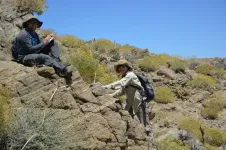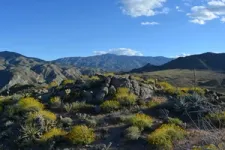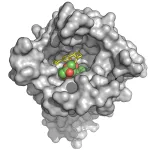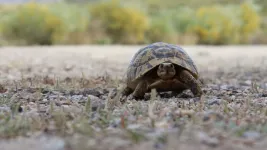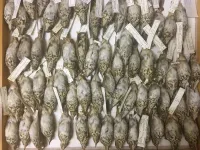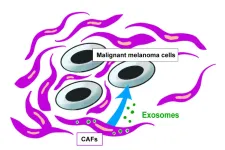(Press-News.org) In North America’s hottest, driest desert, climate change is causing the decline of plants once thought nearly immortal and replacing them with shorter shrubs that can take advantage of sporadic rainfall and warmer temperatures.
Many studies have documented how a hotter, drier world is causing a redistribution of plants in temperate mountain regions. A new UC Riverside study documents the unexpected ways plants in part of the Sonoran Desert are doing the same.
“The plants are shifting, but in weird ways,” said Tesa Madsen-Hepp, first author of the study and UCR evolution and ecology doctoral candidate. “We thought most of them would move to higher elevations with cooler temperatures. But while some lower-elevation trees are declining and shifting upwards, we’re also seeing some other species moving down, toward hotter parts of the desert.”
Furthermore, the researchers believe the trends they observed are likely to continue despite the extreme precipitation events of the past few months. “It’s really the warming temperatures causing the most stress for these species, and a year of rain won’t mitigate the long-term drought trajectory,” Madsen-Hepp said.
Published in the journal Functional Ecology, the research not only documents how some types of plants are shifting downward in elevation but examines those plants’ physical characteristics to explain why the shift is happening.
To make their observations, the research team visited the Boyd Deep Canyon Desert Research Center, just south of Palm Desert, in 2019. The research area spans an 8,000-foot desert-to-mountaintop range across which they traveled from top to bottom sampling plants. This same area had been previously examined by ecologists in both 1977 and 2008, providing a basis for comparison with the more recent findings.
“Species we typically think of as pretty stress tolerant, like California juniper and pinyon pine, are declining, or shifting upwards. And even though they’re shifting up, they don’t appear to be thriving in their new locations,” Madsen-Hepp said. “Moving into their former low-elevation spots are plant species with shallower root systems, like brittlebush, burrow bush, and ocotillo.”
In addition to root systems that don’t rely as much on deep soil water, which is increasingly scarce, these shorter plants are also able to grow faster and invest fewer resources in their leaves.
“These are weedier species. They have “cheaper” leaves in terms of the carbon cost to produce them, and they are drought deciduous,” said Marko Spasojevic, senior author and assistant professor in UCR’s Department of Evolution, Ecology, and Organismal Biology.
“In other words, they can drop the leaves when conditions get too stressful and wait for the drought to be over.”
Plants that keep their leaves year-round tend to invest in thicker leaves with higher carbon content. They are at a disadvantage compared to plants more easily able to shed. When plants drop leaves, the atmosphere can no longer pull water out of them, which eases demand on the roots to provide the lost water.
“The live-slow-die-old strategy that used to work for plants in this environment just isn’t working as well anymore. The increased climate stress in an already extreme environment is pushing them to their physiological thresholds,” Madsen-Hepp said. “Once these plants reach their limit, there is no fixing it. There’s just not much we can do to bring them back,” she said.
The team also found that in contrast to more temperate ecosystems, the lower desert elevations are warming faster than the higher elevations. The shrubs and bushes taking over are not necessarily coming from the highest points in the desert. They’re also lower-elevation plants that have generally expanded their range.
At about 29 meters per decade, the upward range shifts are on par with the higher end of global rates for plant movement in response to climate warming. On average, plants in temperate regions have shown range shift rates between 5 and 30 meters a decade.
“We often think of the tundra as the bellwether for climate change. Arctic and alpine ecosystems are very sensitive. We’re seeing here that this ecosystem is just as sensitive if not more so,” Spasojevic said. “And we already know the answer to easing the stress on it. It’s very simple. Cut fossil fuel emissions.”
END
Even Sonoran Desert plants aren’t immune to climate change
Supposedly drought-tolerant species hit their breaking points
2023-03-28
ELSE PRESS RELEASES FROM THIS DATE:
Pulsing ultrasound waves could someday remove microplastics from waterways
2023-03-28
INDIANAPOLIS, March 28, 2023 — Colorful particles of plastic drift along under the surface of most waterways, from headwater streams to the Arctic Ocean. These barely visible microplastics — less than 5 mm wide — are potentially harmful to aquatic animals and plants, as well as humans. So, researchers are devising ways to remove them and to stop them at their source. Today, a team reports a two-stage device made with steel tubes and pulsing sound waves that removes most of the plastic particles from real water samples.
The researchers will present ...
Modern origami method creates glass shapes by folding
2023-03-28
INDIANAPOLIS, March 28, 2023 — The ancient art of origami is well known for transforming sheets of paper and other foldable materials into complex 3D shapes. But now, chemical engineers have extended the centuries-old practice to produce intricate shapes made of glass or other hard materials. Their thoroughly modern method, which can be combined with 3D printing, could have applications ranging from sculpture to catalysis and beyond.
The researchers will present their results today at the spring meeting of the American Chemical Society (ACS). ACS Spring 2023 is a hybrid meeting being held virtually and in-person ...
Marijuana-derived compounds could reverse opioid overdoses
2023-03-28
INDIANAPOLIS, March 28, 2023 — There’s been a recent push in the U.S. to make naloxone — a fast-acting opioid antidote — available without a prescription. This medication has saved lives, but it’s less effective against powerful synthetic opioids, such as fentanyl. In an interesting twist, researchers are now looking to cannabidiol (CBD), a component of marijuana, as a possible alternative to the popular antidote. Today, a team reports compounds based on CBD that reduce fentanyl binding and boost the effects of naloxone.
The researchers will present their results at the spring meeting of the American Chemical Society (ACS). ...
Is it COVID-19 or the flu? New sensor could tell you in 10 seconds
2023-03-28
INDIANAPOLIS, March 28, 2023 — Have a cough, sore throat and congestion? Any number of respiratory viruses could be responsible. Conventional tests can identify certain likely culprits by relying on chemical reactions, but some researchers want to swap chemistry for electrical changes sensed by nanomaterials. Today, scientists report using a single-atom-thick nanomaterial to build a device that can simultaneously detect the presence of the viruses that cause COVID-19 and the flu — at much lower levels and much more quickly than conventional tests for either.
The researchers will present their results at the spring meeting ...
Shedding pounds may benefit your heart — even if some weight is regained
2023-03-28
Research Highlights:
Weight loss was associated with decreased risk factors for cardiovascular disease and Type 2 diabetes for at least five years — even if some weight was regained, according to a review of research on behavioral weight loss programs.
People who lost weight through an intensive behavioral weight loss program had lower systolic blood pressure levels, total cholesterol-to-good cholesterol ratio and HbA1c levels (a diabetes marker), when compared to people who did not participate in a program or participated in a lower-intensity behavioral program.
Embargoed ...
Turtles and crocodiles with unique characteristics are more likely to go extinct
2023-03-28
New research led by the University of Oxford has revealed that the most endangered turtle and crocodile species are those that are most unique. Their loss could have widespread impacts on the ecosystems they live in, since they carry out critical processes important for many other species.
Turtles and crocodiles are two of the world's most endangered animal groups, with approximately half of species globally threatened (International Union for Conservation of Nature, IUCN). Greater understanding on which species are most threatened and why is urgently needed to inform conservation efforts to save them.
In a new study led by researchers at the Department of Biology, ...
A final present from birds killed in window collisions: poop that reveals their microbiomes
2023-03-28
Every year, millions of birds crash into windows in cities along their migratory path. For decades, scientists and volunteers have risen at dawn in spring and fall to collect the fallen birds, rehabilitating the injured and documenting the dead. The bodies of the birds killed in these collisions are a treasure trove of scientific information, especially when compared year after year. A new study in the journal Molecular Ecology makes use of these specimens to help understand the relationship between birds and the microbes living in their guts—which appears ...
ISTA welcomes first journalists in residence
2023-03-28
Understanding of and trust in science and scientists are dangerously low, and initial studies suggest that a general lack of interest in science is even more of a problem than skepticism in Austria. A key partner in alleviating this mistrust, clearing up misunderstandings, and building up enthusiasm for science must be the media in general and science journalists in particular. However, these journalists need access to the information as well as the resources to work independently and give full flight to their curiosity and creativity. To work towards these goals and promote excellent science journalism, ISTA initiated a program to host journalists for two-to-four-month ...
Candidate found to inhibit malignant melanoma growth
2023-03-28
Malignant melanoma is a relatively aggressive type of skin cancer. When detected early, it is usually treatable by surgical resection only, but metastases develop often spreading to distant areas. Currently, tumor thickness and the presence of ulceration are some of the known prognostic factors used as indicators of malignant melanoma. Therefore, the discovery of valuable markers to assess the malignant potential of melanoma more accurately may be necessary to develop appropriate treatments.
Cross talk between cancer cells and surrounding stromal cells is ...
New form of omega-3 could prevent visual decline with Alzheimer’s disease
2023-03-28
For the first time, researchers have developed a form of the omega-3 fatty acid docosahexaenoic acid (DHA) that is capable of crossing into the eye’s retina to ward off visual declines related to Alzheimer’s disease, diabetes and other disorders.
The DHA found in fish oil capsules and other supplements is typically in a form called triacylglycerol (TAG) DHA. Although TAG-DHA has benefits in other parts of the body, it does not reach the eyes because it cannot travel from the bloodstream into the retina. For the study, ...
LAST 30 PRESS RELEASES:
Automatic label checking: The missing step in making reliable medical AI
Low daily alcohol intake linked to 50% heightened mouth cancer risk in India
American Meteorological Society announces Rick Spinrad as 2026 President-Elect
Biomass-based carbon capture spotlighted in newly released global climate webinar recording
Illuminating invisible nano pollutants: advanced bioimaging tracks the full journey of emerging nanoscale contaminants in living systems
How does age affect recovery from spinal cord injury?
Novel AI tool offers prognosis for patients with head and neck cancer
Fathers’ microplastic exposure tied to their children’s metabolic problems
Research validates laboratory model for studying high-grade serous ovarian cancer
SIR 2026 delivers transformative breakthroughs in minimally invasive medicine to improve patient care
Stem Cell Reports most downloaded papers of 2025 highlight the breadth and impact of stem cell research
Oxford-led study estimates NHS spends around 3% of its primary and secondary care budget on the health impacts of heat and cold in England
A researcher’s long quest leads to a smart composite breakthrough
Urban wild bees act as “microbial sensors” of city health.
New study finds where you live affects recovery after a hip fracture
Forecasting the impact of fully automated vehicle adoption on US road traffic injuries
Alcohol-related hospitalizations from 2016 to 2022
Semaglutide and hospitalizations in patients with obesity and established cardiovascular disease
Researchers ‘listen in’ to embryo-mother interactions during implantation using a culture system replicating the womb lining
How changing your diet could help save the world
How to make AI truly scalable and reliable for real-time traffic assignment?
Beyond fragmented markets: A new framework for efficient and stable ride-pooling
Can shape priors make road perception more reliable for autonomous driving?
AI tracks nearly 100 years of aging research, revealing key trends and gaps
Innovative techniques enable Italy’s first imaging of individual trapped atoms
KIER successfully develops Korea-made “calibration thermoelectric module” for measuring thermoelectric device performance
Diversifying US Midwest farming for stability and resilience
Emphasizing immigrants’ deservingness shifts attitudes
Japanese eels, climate change, and river temperature
Pusan National University researchers discover faster, smarter heat treatment for lightweight magnesium metals
[Press-News.org] Even Sonoran Desert plants aren’t immune to climate changeSupposedly drought-tolerant species hit their breaking points
